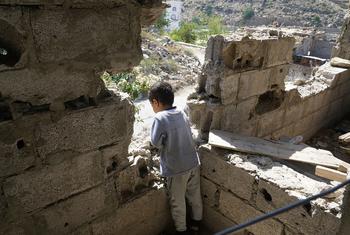More than 11,000 children killed or injured in Yemen conflict: UNICEF
More than 11,000 boys and girls have been killed or injured in the war in Yemen – an average of four a day since fighting escalated in 2015, though the number is likely to be far higher, the UN Children’s Fund (UNICEF) has reported.
The landmark agreement was initially announced in April and led to a significant reduction in the intensity of the conflict.
However, a further 62 children have been killed or injured in the period since it ended in early October and 30 November, UNICEF said.
Struggling to survive
Furthermore, at least 74 children were among the 164 people killed or injured by landmines and unexploded ordnance between July and September alone.
Ms. Russell visited a hospital in the city of Aden where she met Yasin, a seven-month-old boy, and his mother, Saba, for whom life has become a struggle for survival.
“Thousands of children have lost their lives, hundreds of thousands more remain at risk of death from preventable disease or starvation,” she said.
“Yasin is just one of too many severely malnourished children in Yemen. They all need immediate support as basic services have all but collapsed.”
Young lives at risk :
During her visit, Ms. Russell launched UNICEF’s $10.3 billion Humanitarian Action for Children Appeal to provide water, sanitation, nutrition, education, health and protection services to children worldwide affected by conflict and disasters.
Yemen remains one of the world’s most pressing humanitarian situations. More than 23.4 million people, or three-quarters of the population, require assistance and protection. More than half are children.
UNICEF estimated that 2.2 million youngsters are acutely malnourished, including nearly 540,000 under-fives who are suffering from severe acute malnutrition.
More than 17.8 million Yemenis lack access to safe water, sanitation and hygiene services, while the country’s health system has been extremely fragile for years.
Only half of all health facilities are functional, leaving almost 22 million people – including around 10 million children – without adequate access to care.

